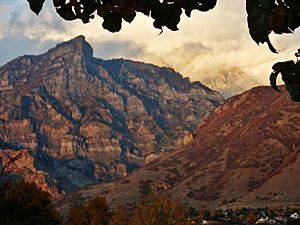Rock Canyon (Provo, Utah) facts for kids
Rock Canyon is a cool spot found in the Wasatch Mountains in eastern Provo, Utah, United States. It's a favorite place for rock climbers, hikers, and other outdoor adventurers. People love it because of its unique and rugged rocks, and it's super close to Brigham Young University. The entrance to the canyon is right behind the Provo Utah Temple.
Contents
Cool Places to See in Rock Canyon
Rock Canyon is home to several interesting landmarks:
- Kyhv Peak (this peak used to be called Squaw Peak)
- Cascade Mountain
- The old shoreline of Lake Bonneville
- The Wasatch Fault
- Monarch Mine (also known as Buckley Mine)
- Spanish Moss Cave
- Red Baron Cave
History of Rock Canyon
The recorded history of Rock Canyon starts around 1850. This was when Mormon settlers from Fort Utah had conflicts with the Timpanogos tribe, who lived in Utah Valley. After a battle, some Timpanogos, led by Big Elk, went to Rock Canyon. The settlers named the peak north of the canyon "Squaw Peak" after Big Elk's wife, who died there during the conflict.
You can still find some old Indian drawings, called pictographs, in the canyon. There are also many old mining tunnels and shafts from when people dug for minerals. Rock climbers have found many routes to climb throughout the canyon too.
Wildlife in Rock Canyon
Rock Canyon is a home for many wild animals. Visitors often see deer and bighorn sheep. You might even spot other types of wildlife if you are lucky!
Geology: The Story of Rock Canyon's Rocks
Rock Canyon is a great place to see very old rocks. Most of these rocks formed during the Paleozoic Era. At the canyon's entrance, you can see even older rocks from the Precambrian time. Further inside, there are newer deposits from the Quaternary period, left by glaciers and landslides.
The canyon shows how the area has changed over millions of years. This includes:
- How sediments were laid down and turned into rock.
- How the rocks were squeezed and shortened from north to south.
- How the rocks folded and shifted due to thrust faulting.
- How the Wasatch Fault lifted the land, exposing these rocks.
- How streams carved out the canyon over time.
As you walk up the canyon trail, you are actually walking through different layers of rock, from the oldest at the entrance to the youngest deeper inside. It's like walking through a timeline of Earth's history!
Here are some of the rock layers you can see, starting from the oldest at the canyon's mouth:
- Mineral Fork Tillite: This rock is olive-colored and has larger rocks mixed into a fine mud.
- Tintic Quartzite: This rock is tan to orange. It's very cracked, but you can still see the original cross bedding from when it was sand.
- Ophir Formation
- Maxfield Limestone
- Fitchville Dolomite
- Gardison Limestone
- Deseret Limestone
- Humbug Formation
- Great Blue Limestone Formation
- Manning Canyon Shale
- Oquirrh Group (which includes Bridal Veil Falls, Bear Canyon, Shingle Mill, and Wallsburg Ridge Formations)



